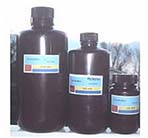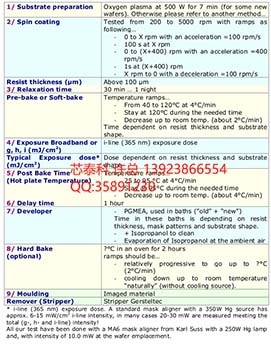研究所、永久材、MEMS专用 GM 1075
发布日期:2024/11/5 1:05:40
浏览次数:
点赞数:
收藏数:
关注数:
【赞一个】 【举报】 【收藏】 【关注】
研究所、永久材、MEMS专用 GM 1075
Gersteltec SU-8 series
深圳市芯泰科光电有限公司
产品热线许经理 :13玖23八66554 扣扣:35捌9123零
深圳市芯泰科光电有限公司,创立于2014年,是一家服务于微电子领域的产品贸易及技术服务提供商。我们已经成为国内微电子制程领域和相关大学研究所信赖的合作伙伴;公司秉持以忠诚态度对待新旧客户,以客户满意为导向,提供优质高效率的专业服务,提供产品行销及技术支援解决方案。我们目标是成为一家新材料应用技术推广服务的专业供应商。
主要产品范围 :
一、 光刻:正性光刻胶和负性光刻胶
二、 保护胶:抗反射涂层、晶圆切割保护胶和键合胶
三、 其它辅助化学品:显影液、清洗剂、去胶液和剥离液
Gersteltec SU-8 series
GM 1075(SU-8-negative tone photo-epoxy
for thick layers (>100 μm) )
General information
SU-8 is an epoxy based, chemically
amplified
resist
system
with
excellent sensitivity high
aspect ratios. The primary
applications are Micro-fabricated
Mechanical Structures (MEMS)
other Microsystems.
Examples are sensors, micro-fluidic
components, electronic coils, inkjet
print head nozzles, multi-chip
modules, actuators, LCD spacers
moulds for plastic, stamps for
hot embossing electroplating.
Datasheet parts…
1 / Schematics of the process
2 / Process description
3 / Process parameters
4 / Processing GM1075 – Overview
5 / Typical processes (100μm, 150μm, 200μm, 300μm, 350μm 400μm)
6 / Troubleshooting
1 / Schematics of the process
2 / Process description
A typical SU-8 process consists of
-
Substrate preparation (dehydration, cleaning…)
- Spin-coating
- Relaxation time to improve the surface uniformity
- Soft Bake
Exposure to initiate the cross-linking
- Post Exposure bake (PEB), to cross-link exposed regions.
- Development
Rinse & dry
- Hard Bake (or curing-optional)
- Imaged material (optional: in case of moulding)
- Remove (optional: in case of moulding)
(in chronological order)
Put the substrate in an oven at a minimum temperature of 130 °C during at
least 20 minutes to remove adsorbed water the substrate surface.
Alternatively use an oxygen plasma for 7 min at 500 Watts in a Microwave
plasma reactor. This should increase the temperature inside the plasma
chamber above 80°C after the 2 first minutes.
Stard HMDS procedure is not recommended for GM 10series on SiO2 based
wafers.
Spin-coat the resist after cooling down the substrates, at the wanted speed (X)
level during 100 seconds with a 100 rpm/s acceleration, followed by a 400
rpm/s acceleration up to (X+400) speed during 1s then a deceleration ramp
about 100 rpm/s.
Relax (optional) the resist 1 hour up to 1 night, depending on the resist
thickness the uniformity wanted. If there are some bubbles just after spin
coating they can be burst using a clean thin tip. The created hole should be
removed during the required time. Finally this relaxation time should improve
the uniformity of the layer, evaporate some portion of solvent.
Softbake the coated substrate. All the temperature ramps should be about
4°C/min. After making an optional relaxation at 40°C, increase the temperature
up to 120 °C let he wafers as much time as necessary that, when holding
them at room temperature with some tweezers there are not printed on the SU
8 layer! Then you can switch off the power or decrease temperature until they
reach the room temperature.
Expose the coated substrate with the mask. This exposure dose adjusts the
negative wall profile whom slope is closed to 90°. Have a look on the exposure
curve to choose as a function of your thickness the dose that gives not any
cracks, un-sticking or “stairs effect”.
Note: Exposure doses refer to i-line (365nm). A stard mask aligner with a
350W Hg light source has approx. 6-15 mW/cm2 i-line intensity, while in
many cases 20-30 mW/cm2 are measured meeting the total (g-, h- i-line)
intensity!
Ideally
you should try some multiple exposure around the given exposure dose
on the Exposure curve. In fact your results may not be exactly the same
because of the UV lamp parameters. So you have to optimise this exposure dose
parameter simply because your mask aligner is probably not the same than our.
Delay time: Keep the coated substrate at room temperature after the exposure
for at least 10 minutes. In this delay time some chemical species will diffuse on
the exposed parts giving more homogeneity on the amplification phenomenon.
Post Exposure Bake (PEB): after the delay bake the coated substrate at the
same temperature profile than for the Soft Bake but at 95°C instead of 120°C.
Lower temperature will induce a lower internal stress. This step accelerates the
cross-linking of the exposed areas making them insoluble in the developer.
Develop in PGMEA. When the structure is through-developed (cleared), add
another 10% of the time in a cleaned bath of the total development time to
finalize the side wall profile.
Rinse with Isopropanol. Once there is not any more white traces the
development is then finished. Unfortunately, if you add even more than a few
seconds, the SU-8 layer that should be unsticking the substrate.
Dry the wafers just letting them at the ambient air, on a wet bench with an
appropriate air flow (exhaust).
Hard-bake (optional) the coated substrate if after drying there are some
unstuck SU-8 or cracks. Only the smallest cracks (<5 μm) will be totally
removed after this step.
Optional…
Imaged material (optional: in case of moulding): deposition of you material by
sputtering, electrodepositing…
Remove SU-8: using the Gersteltec SU-8 strippe
3 / Process parameters
4 / Processing GM1075 - Overview
5 / Typical processes (100, 150, 200, 300, 350 & 400 μm)
Firstly, the wafer preparation should be as mentioned previously (Oxygen plasma at
500W for min 7min (for some cleaned wafers yet)…).
6 / Troubleshooting
Cracks: theses drawbacks appear as a function of the exposure dose,
temperature ramps taken Pre-bake time. Try to increase the exposure dose
range by some x10 mJ/cm2, if you want to try multiple exposure. Consequently,
you will see the quality of the surface changing.
White traces after development: This is only because there is still some
unexposed SU-8 not totally developed. In fact unexposed SU-8+Isopropanol
makes a white complex that you can find on your wafers.
In the other side, just pay attention to not develop to much time. Otherwise you
could unstuck the SU-8 layer the substrate.
Appendix
Our machines…:
-
Spin-coating
: RC-8 Karl Suss
-
Mask aligner
: MA6 mask aligner Karl Suss with a 250W Hg lamp ,
with intensity of 10.0 mW at the wafer emplacement. -- -Hotplates
Karl Suss.
- Thickness measurements
: AlphaStep 500.








